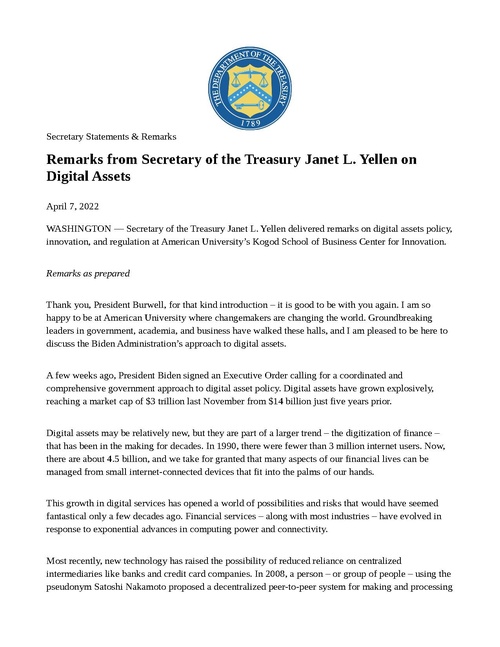Treasury Remarks on Digital Assets
| News | |
| Image | 
|
|---|---|
| Published | 2022-04-07 |
| Point(s) of Contact | press@treasury.gov |
| Organization(s) | US Deptartment of the Treasury |
| Where | Washington DC, American University |
| Display | Yes |

| |
Secretary of the Treasury Janet L. Yellen delivered remarks on digital assets policy, innovation, and regulation at American University’s Kogod School of Business Center for Innovation.
Very important speech today from Acting Comptroller Michael Hsu on stablecoins. At a high level, Acting Comptroller Hsu's speech represents a move toward a more balanced and constructive engagement with crypto generally and stablecoins specifically. Hsu has hitherto been a crypto skeptic, likening crypto assets to the credit default swaps that contributed to the 2008 financial crisis, among other things.
Key points:
(1) Hsu highlights fact that 1/5 Americans are invested in crypto, a group that is disproportionately young, diverse, and underbanked. This is an important point as it indicates he is aware of the demographics of crypto.
(2) He bypasses whether or not Web3 or crypto is a negative or positive development by focusing on ensuring stability of stablecoin ecosystem that underpins much of the crypto markets.
(3) Hsu also argues that the appropriate regulators for stablecoins are banking regulators but that doesn't stablecoin issuers need not be subject to full panoply of banking regulations - instead "a tailored set of bank regulatory and supervisory requirements could balance stability with efficiency."
(4) Finally, he directs attention to two forms of interoperability, (i) within a stablecoin across blockchains noting that "A user cannot use the Tron native USDT token to pay for something on the Ethereum blockchain, at least not without a cross-chain solution of some kind. And as many have come to learn the hard way, cross-chain solutions have proven to be highly vulnerable to hacks." (ii) Interoperability across stablecoins, he opines that "[i]n the long-run, interoperability between stablecoins and with the dollar— including a CBDC—would help ensure openness and inclusion. It would also help facilitate broader use of the U.S. dollar—not a particular corporate-backed stablecoin—as the base currency for trade and finance in a blockchain-based digital future."
(5) He also highlights the risk of stablecoin issuance to a larger banking organization, focusing on "intraday liquidity risk." "Banks’ intraday controls and risk management systems for traditional Fedwire payments may not be effective for blockchain-based payments, which are on 24/7, irreversible, and settle in real-time. The accumulation of blockchain-based payments over, say, a weekend could outstrip a bank’s available liquidity resources." This risk could be resolved through standalone stablecoin bank affiliates under a bank holding company, for example, and/or new rules for interaffiliate transactions involving stablecoins.
Overall, a great speech and another milestone indicating a shift to a more realistic, constructive, and balanced approach to oversight of digital assets.